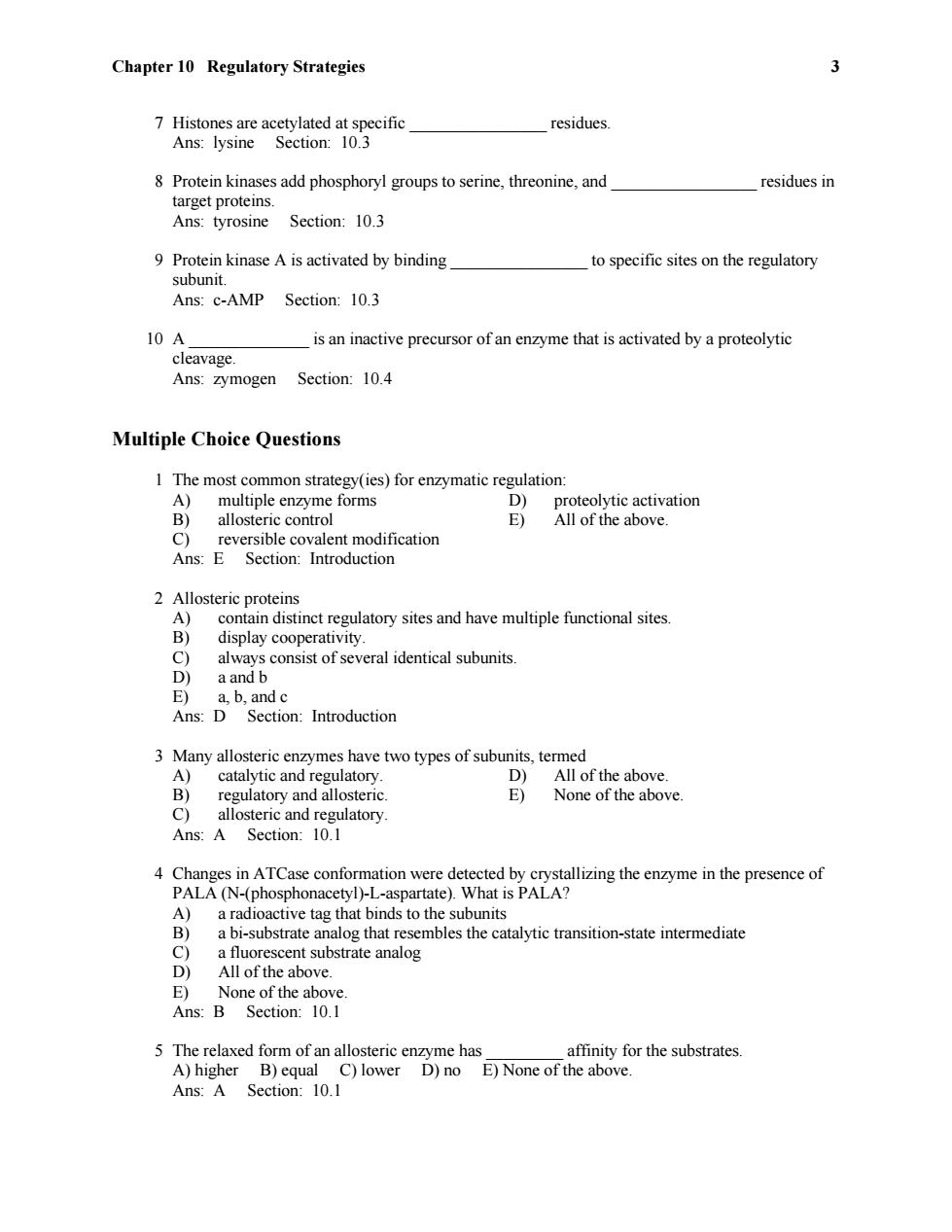正在加载图片...

Chapter 10 Regulatory Strategies 3 7 Histones are acetylated at specific residues. Ans:lysine Section:10.3 8 Protein kinases add phosphoryl groups to serine,threonine,and residues in target proteins. Ans:tyrosine Section:10.3 9 Protein kinase A is activated by binding to specific sites on the regulatory subunit. Ans:c-AMP Section:10.3 10A is an inactive precursor of an enzyme that is activated by a proteolytic cleavage. Ans:zymogen Section:10.4 Multiple Choice Questions 1 The most common strategy(ies)for enzymatic regulation: A) multiple enzyme forms D) proteolytic activation B) allosteric control E) All of the above C) reversible covalent modification Ans:E Section:Introduction 2 Allosteric proteins A) contain distinct regulatory sites and have multiple functional sites. B) display cooperativity C) always consist of several identical subunits D) a and b E)a,b,and c Ans:D Section:Introduction 3 Many allosteric enzymes have two types of subunits,termed A) catalytic and regulatory. D All of the above. B) regulatory and allosteric. E) None of the above. C)allosteric and regulatory Ans:A Section:10.1 4 Changes in ATCase conformation were detected by crystallizing the enzyme in the presence of PALA (N-(phosphonacetyl)-L-aspartate).What is PALA? A)a radioactive tag that binds to the subunits B)a bi-substrate analog that resembles the catalytic transition-state intermediate C)a fluorescent substrate analog D)All of the above. E)None of the above Ans:B Section:10.1 5 The relaxed form of an allosteric enzyme has affinity for the substrates. A)higher B)equal C)lower D)no E)None of the above. Ans:A Section:10.1Chapter 10 Regulatory Strategies 3 7 Histones are acetylated at specific ________________ residues. Ans: lysine Section: 10.3 8 Protein kinases add phosphoryl groups to serine, threonine, and _________________ residues in target proteins. Ans: tyrosine Section: 10.3 9 Protein kinase A is activated by binding ________________ to specific sites on the regulatory subunit. Ans: c-AMP Section: 10.3 10 A ______________ is an inactive precursor of an enzyme that is activated by a proteolytic cleavage. Ans: zymogen Section: 10.4 Multiple Choice Questions 1 The most common strategy(ies) for enzymatic regulation: A) multiple enzyme forms D) proteolytic activation B) allosteric control E) All of the above. C) reversible covalent modification Ans: E Section: Introduction 2 Allosteric proteins A) contain distinct regulatory sites and have multiple functional sites. B) display cooperativity. C) always consist of several identical subunits. D) a and b E) a, b, and c Ans: D Section: Introduction 3 Many allosteric enzymes have two types of subunits, termed A) catalytic and regulatory. D) All of the above. B) regulatory and allosteric. E) None of the above. C) allosteric and regulatory. Ans: A Section: 10.1 4 Changes in ATCase conformation were detected by crystallizing the enzyme in the presence of PALA (N-(phosphonacetyl)-L-aspartate). What is PALA? A) a radioactive tag that binds to the subunits B) a bi-substrate analog that resembles the catalytic transition-state intermediate C) a fluorescent substrate analog D) All of the above. E) None of the above. Ans: B Section: 10.1 5 The relaxed form of an allosteric enzyme has _________ affinity for the substrates. A) higher B) equal C) lower D) no E) None of the above. Ans: A Section: 10.1